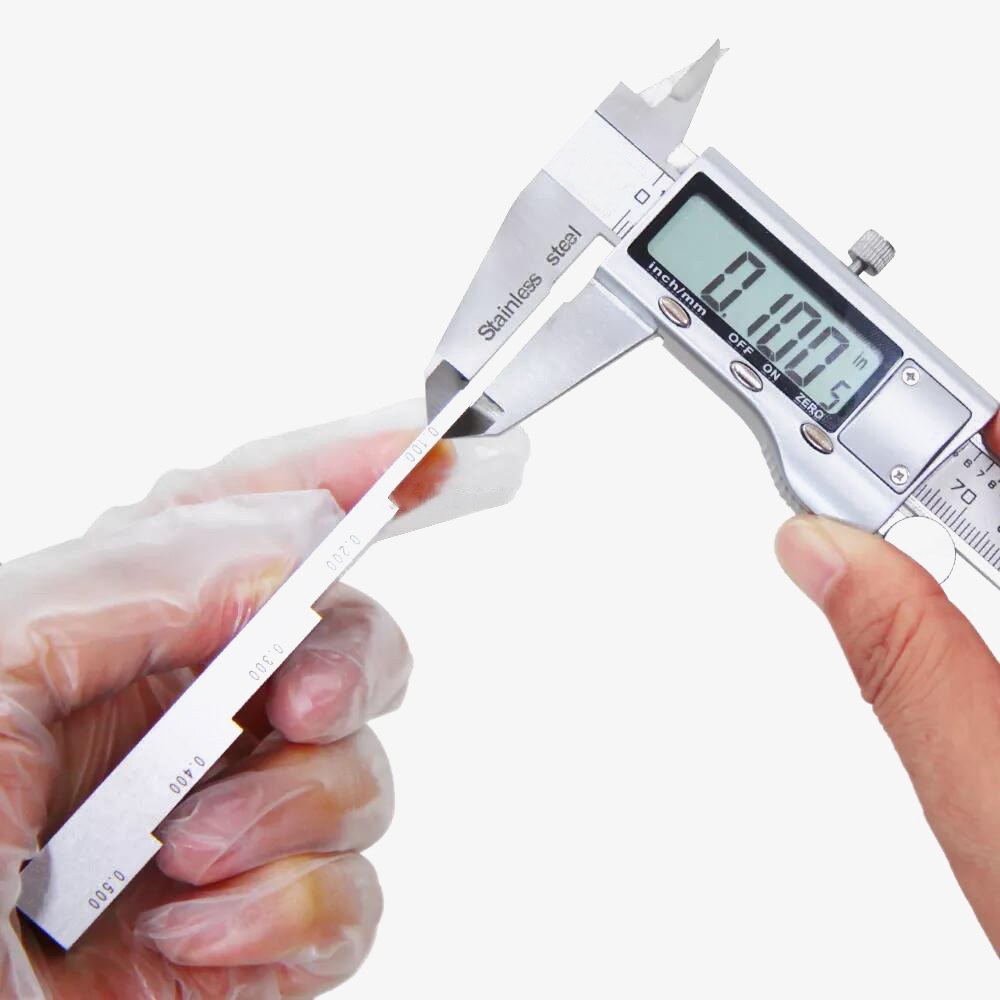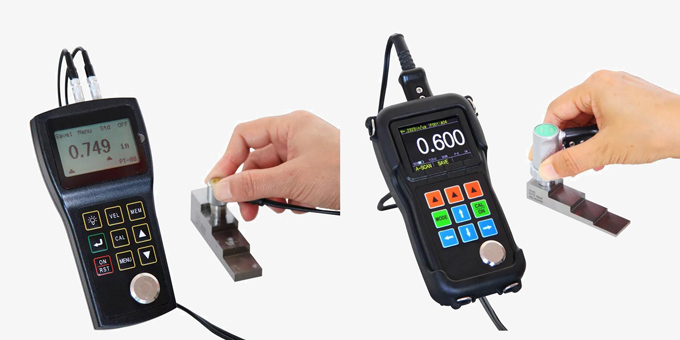Buy a calibration block for ultrasonic testing. It is available with 4 step, 5 step, 6 step and 10 step in millimeters and inches. The step wedge calibration block is made of 1018 steel, with a durable ABS carrying case, used for sisco ultrasonic thickness gauges.

Ultrasonic thickness calibration block is designed for ultrasonic thickness gauge.
- Standard Ultrasonic Step Block: 4 step, 5 Step, 6 step, and 10 step ultrasonic calibration blocks for selection.
- NDT UT Block Standard Material: 1018 Steel is provided.
- Standard UT Block: 1mm -25mm calibration block is optional.
Applications

| Model | Item | Parameter | Size | Material |
| SISCO-B-101-0001 | 4 step calibration block | 3mm 5mm 10mm 15mm | 80 x 20mm | 1018 Steel |
| SISCO-B-101-0012 | 0.100” 0.200” 0.400” 0.600” | 3.15 x 0.7in | 1018 Steel | |
| SISCO-B-101-0002 | 0.250” 0.500” 0.750” 1.000” | 3.15 x 0.8 inch | 1018 Steel | |
| SISCO-B-101-0013 | 5 step calibration block | 5mm 10mm 15mm 20mm 25mm | 100 x 20mm | 1018 Steel |
| SISCO-B-101-0003 | 0.100” 0.200” 0.300” 0.400” 0.500” | 4 x 0.8 inch | 1018 Steel | |
| SISCO-B-101-0004 | 6 step calibration block | 1mm 3mm 5mm 10mm 15mm 20mm | 120 x 20mm | 1018 Steel |
| SISCO-B-101-0005 | 2.5mm 5mm 10mm 15mm 20mm 25mm | 120 x 20mm | 1018 Steel | |
| SISCO-B-101-0006 | 10 step calibration block | 1mm 2mm 3mm 4mm 5mm 6mm 7mm 8mm 9mm 10mm | 200 x 20mm | 1018 Steel |
| SISCO-B-101-0007 | 2mm 4mm 6mm 8mm 10mm 12mm 14mm 16mm 18mm 20mm | 200 x 20mm | 1018 Steel | |
| SISCO-B-101-0008 | 0.100” 0.200” 0.300” 0.400” 0.500” 0.600” 0.700” 0.800” 0.900” 1.000” | 8 x 0.8 inch | 1018 Steel | |
| SISCO-B-101-0009 (Round Tube Test Block) | 5 step calibration block | 2.5mm 5mm 10mm 15mm 20mm Inner Tube Diameter: 20.0 mm, Width: 20.0 mm × 120°a | 100mm | 1018 Steel |
Q1: What is an ultrasonic thickness gauge?
The ultrasonic thickness gauge is improved based on the principle of ultrasonic measurement. It can measure the thickness of metals and other materials and can measure the sound speed of the material. The sisco ultrasonic thickness gauge is a portable thickness meter that can measure the thickness of various pipes and pressure vessels in production equipment, as well as accurately measure various sheets and machined parts.
Q2: How does an ultrasonic thickness gauge work?
sisco ultrasonic thickness gauge offers through-coating thickness measuring capability. It measures the thickness of an object by precisely calculating the times the probe sends an ultrasonic pulse to the object and passes through the object until the probe receives the reflection from the boundary. The ultrasonic pipe thickness gauge adopts the most advanced microprocessor and ultrasonic technology and has the characteristics of zero drift, reliable and stable reading, and no need for zero calibration. You can now test painted objects without removing paint or correcting paint thickness.
Q3: 4 Measurement methods of ultrasound thickness gauge
- Single-point measurement method: It means that the ultrasound thickness gauge is used to measure any point of the measured material with a probe, and the display value is the thickness value.
- Two-point measurement method: The ultrasound thickness meter is used to make two measurements at the same point of the measured material with a probe. In the second measurement, the probe's split surface is 90 degrees, and the smaller value in the two measurements is the thickness value.
- Multi-point measurement method: When the measurement value is unstable, take a measuring point as the center and make multiple measurements in a circle with a diameter of about 30 mm. The minimum value is the thickness value.
- Continuous measurement method: It uses a single-point measurement method to measure continuously along a designated line with an interval of not less than 5 mm. The minimum value is the thickness value.
Tips: Why are calibration blocks used for ultrasonic thickness gauges?
The ultrasonic thickness gauge is used to accurately measure the thickness of different materials under different conditions. In order to meet the requirements of the maximum accuracy measurement, a set of reference test blocks or calibration block will be very important. The closer the material of the calibration block is to the material to be tested, the more accurate the measurement. The ideal reference test block is a set of test pieces of different thicknesses of the material to be tested. The calibration block can offer the UT instrument compensation correction factors.
In most cases, using one calibration block can obtain satisfactory measurement accuracy. This reference test block should have the same material and similar thickness as the tested material.
For thin materials, when its thickness is close to the lower limit of probe measurement, the calibration block can be used to determine the exact lower limit. Do not measure materials below the lower limit of thickness. If a thickness range can be estimated, the upper limit should be chosen for the thickness of the calibration block.
As for the thick material to be tested, especially for alloys with complex internal structures, the one among the reference block that is close to the tested material should be selected, so as to facilitate calibration.
Thank you for buying industrial test and measurement equipment on SISCO.com, all products sold by SISCO and the partner cover a 12 months warranty, effective from the date of receiving the products.
What is covered?
SISCO is responsible for providing free spare parts, and free technical support to assist the customer to repair the defective products until the problem is solved.
What is not covered?
- Product purchased from anyone other than a SISCO store or a SISCO authorized reseller.
- Expendable parts.
- Routine cleaning or normal cosmetic and mechanical wear.
- Damage from misuse, abuse or neglect.
- Damage from use of parts other than SISCO approved.
- Damage from use outside the product’s usage or storage parameters.
- Damage from use of parts not sold by SISCO.
- Damage from modification or incorporation into other products.
- Damage from repair or replacement of warranted parts by a service provider other than a SISCO authorized service provider.
- Damage caused by the application environment not meeting the product usage requirements and the failure to perform preventive maintenance.

